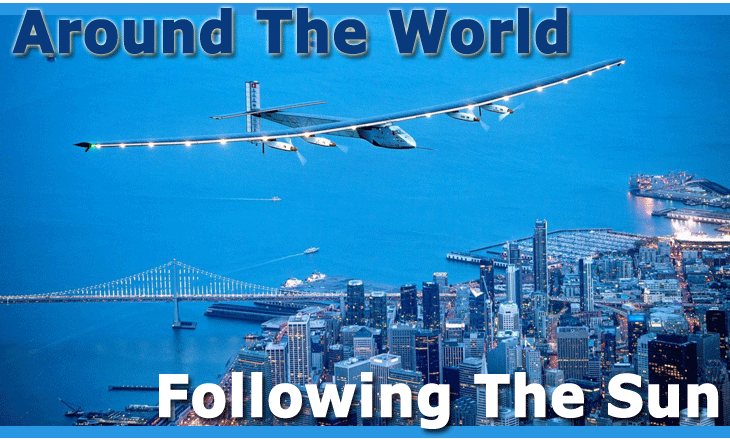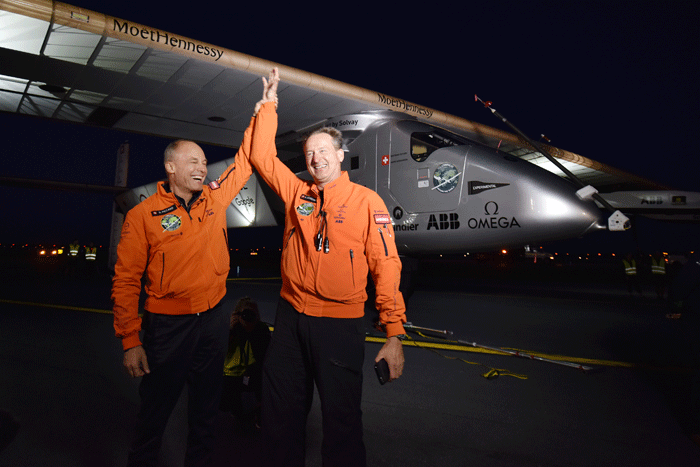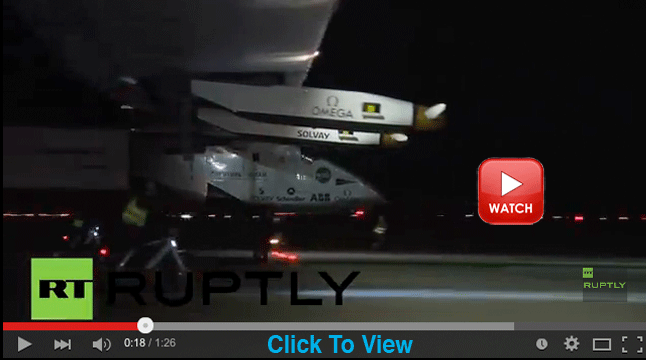
It
felt a bit like the fabled departure of “The Lone
Eagle,” when Charles Lindbergh took off in the
dark for Paris 89 years ago.

Swiss pilot Andre Borschberg
(right), Co-founder, CEO and pilot of Solar Impulse,
and fellow pilot Bertrand Piccard, Initiator and
Chairman of Solar Impulse, celebrate after landing
the sun-powered Solar Impulse 2 at JFK International
Airport in New York, NY, on June 11, 2016. |
But this was
2016. The Swiss-made Solar Impulse 2 landed at John
F. Kennedy International Airport on Saturday, June 11,
at 4 a.m. It had just traveled for 4 hours and 41 minutes
on a trip of 165 miles from Lehigh Valley International
Airport in Pennsylvania.
The aircraft reached a milestone
last weekend. Its globe-circling voyage began more than
a year ago in the United Arab Emirates, but last Saturday
The Solar Impulse 2 completed a trip across the United
States with a Statue of Liberty fly-by before landing
in New York.
“Si2 is now safe in New
York, JFK airport . . . Our new home is Hangar 19 in
John F. Kennedy International Airport!" the pilots'
logbook read.
Pilot Andre Borschberg, who
flew the plane to New York, and pilot Bertrand Piccard,
who will start the next leg of the journey, expect to
leave "soon" to cross the Atlantic Ocean for
Europe or South Africa. They are quickly on their way
to completing an aviation engineering feat that will
advance environmentally compatible technology.
If they fly the northern Atlantic,
the route will probably follow Lindbergh’s great
circle route trail, hugging the landmasses and jumping
from country to country before facing the stretch of
the northern ocean until arrival on mainland Europe.
The trip will begin early morning, moving very late
into the night and the wee small hours of the morning.
A South American attempt to
cross the Atlantic would probably also mimic earlier
pioneers of aviation by picking the shortest crossing,
perhaps Natal Brazil to Dakar, for example.
SI2 can store enough power
to keep it going all night “but needs sun the
next day,” the pilots quip.
Solar Impulse 2’s wings,
which stretch wider than those of a Boeing 747, are
equipped with 17,000 solar cells that power propellers
and charge batteries. The plane runs on stored energy
at night. Ideal flight speed is about 28 mph, although
that can double during the day when the sun’s
rays are strongest.
The plane’s schedule
is understandably affected by the weather, so with a
completely flexible schedule showers and thunderstorms
caused it to be grounded.
The trip began in March 2015
from Abu Dhabi, the capital of the United Arab Emirates,
and made stops in Oman, Myanmar, China, and Japan. The
plane had a five-day trip from Japan to Hawaii, where
the crew “was forced to stay in Oahu” for
nine months after the plane’s battery system sustained
heat damage on its trip from Japan.
Missing from all of this was
the suggestion of a commercial (god forbid) air cargo
value, which might be developed for these flights as
technology advances lift and payload.
What a thing it would be to
receive a bag of mail or some flowers, or any air cargo
delivered by solar power—flying low, slow, and
cheap, but still faster than ocean.
Geoffrey
 |
|




 Vol
15. No. 43
Vol
15. No. 43 Vol
15. No. 44
Vol
15. No. 44